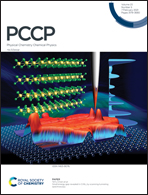Endo- and exohedral chloro-fulleride as η5 ligands: a DFT study on the first-row transition metal complexes†
Abstract
C60 fullerene coordinates to transition metals in η2-fashion through its C–C bond at the 6-6 ring fusion site, whereas other coordination modes η3, η4, η5 and η6 are rarely observed. The coordination power of C60 to transition metals is weak owing to the inherent π-electron deficiency on each C–C bond as 60 electrons get delocalized over 90 bonds. The encapsulation of Cl− by C60 describes a highly exothermic reaction and the resulting Cl−@C60 behaves as a large anion. Similarly, the exohedral chloro-fulleride Cl−C60 acts as an electron-rich ligand towards metal coordination. A comparison of the coordinating ability of Cl−@C60 and Cl−C60 with that of the Cp− ligand is done for early to late transition metals of the first row using the M06L/6-31G** level of density functional theory. The binding energy (Eb) for the formation of endohedral (Cl−@C60)(MLn)+ and exohedral (Cl−C60)(MLn)+ complexes by the chloro-fulleride ligands ranges from −116 to −170 kcal mol−1 and from −111 to −173 kcal mol−1, respectively. Variation in Eb is also assessed for the effect of solvation by o-dichlorobenzene using a self-consistent reaction field method which showed 69–88% reduction in the binding affinity owing to more stabilization of the cationic and anionic fragments in the solvent compared to the neutral product complex. For each (Cl−@C60)(MLn)+ and (Cl−C60)(MLn)+ complex, the energetics for the transformation to C60 and MLnCl is evaluated which showed exothermic character for all endohedral and exohedral Co(I) and Ni(II) complexes. The rest of the exohedral complexes, viz. Sc(I), Ti(II), Ti(IV), V(I), Cr(II), Mn(I), Fe(II) and Cu(I) systems showed endothermic values in the range 2–35 kcal mol−1. The anionic modification makes the C60 unit a strong η5 ligand similar to Cp− for cationic transition metal fragments. The bulky anionic nature and strong coordination ability of chloro-fulleride ligands suggest new design strategies for organometallic catalysts.



 Please wait while we load your content...
Please wait while we load your content...